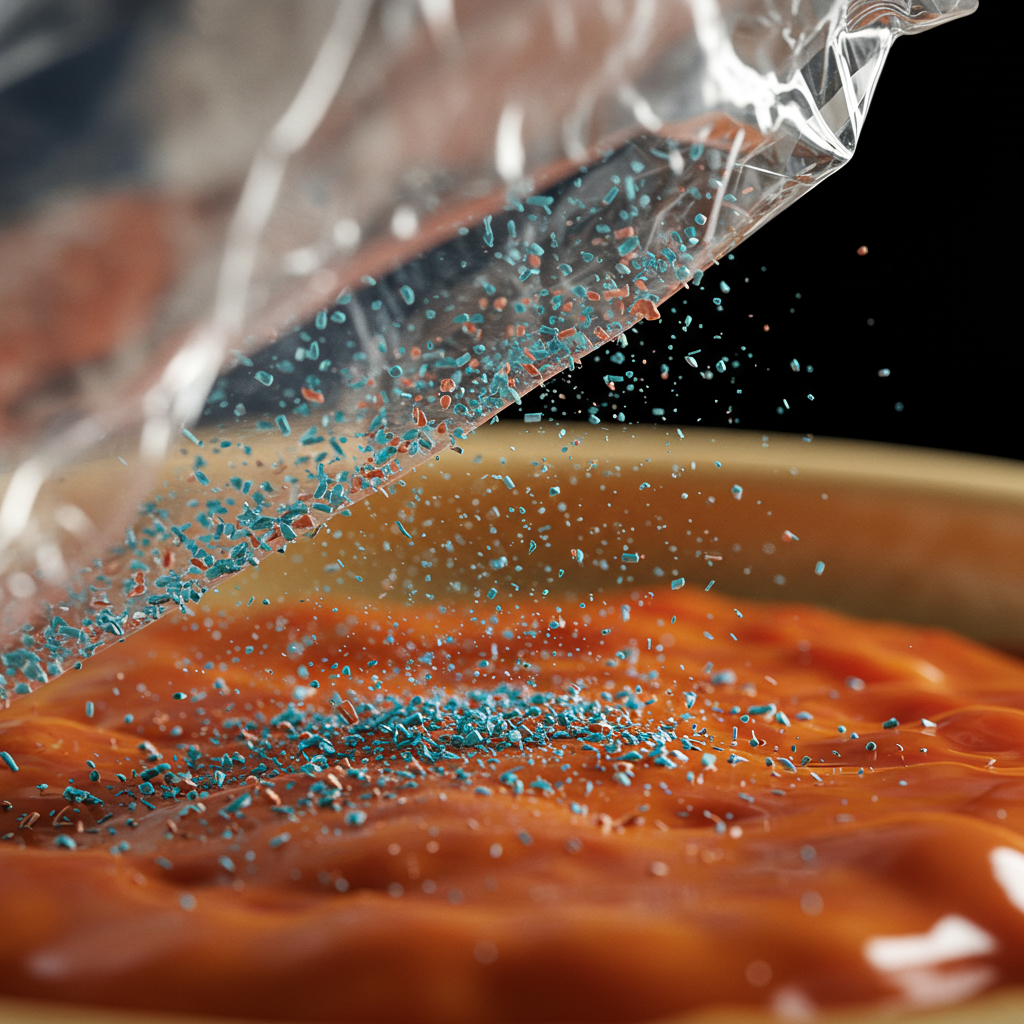plastic food packaging and containers shed microscopic particles into your meals and drinks during everyday use, according to a significant new review of scientific studies. This contamination affects both single-use items and reusable plastics. It highlights the pervasive presence of microplastics and nanoplastics (MNPs) in our food chain, prompting calls for more research and precautionary measures to limit human exposure.
Everyday Use Leads to Contamination
Simply using plastic food packaging and containers as intended is enough to release tiny plastic particles. A comprehensive review of 103 scientific studies on microplastic food contamination found this shedding is widespread. Actions as basic as opening a plastic bottle or using a plastic chopping board can release these microscopic fragments.
The review, led by biologist Lisa Zimmermann at the non-profit Food Packaging Forum in Switzerland, analyzed 600 entries related to food contact articles from the studies. An alarming 96 percent of these entries reported the presence of MNPs. This indicates that plastic food contact materials are a direct and significant source of the micro- and nanoplastics found in our food.
Common Sources of Plastic Shedding
Many common items you interact with daily contribute to this problem. This includes:
Plastic drink bottles (just by opening)
Plastic chopping boards
Plastic-lined pizza boxes
Plastic-lined disposable coffee cups
Plastic tea bags
Plastic wrappings
Microwaveable plastic containers
Even items that aren’t purely plastic, like glass bottles with a plastic gasket, can shed particles. The shedding happens easily and constantly.
How Plastic Releases Particles
Plastic degrades over time and through physical stress. Heat significantly accelerates this breakdown. Microwaving food in plastic containers, for instance, can cause substantial shedding. Even containers labeled “microwave safe” may only indicate they won’t melt, not that they are safe from shedding microscopic particles into your food.
Physical abrasion also causes shedding. Using a plastic chopping board, for example, scrapes tiny plastic fragments off the surface with every cut. Repeated washing, especially in a dishwasher, can worsen this for reusable plastic items like melamine bowls. High temperatures and harsh detergents in dishwashers accelerate the degradation of plastic materials.
Ultra-Processed Foods Show Higher Levels
The review highlighted another interesting finding: ultra-processed foods tend to contain more microplastics than minimally processed foods. The reason is straightforward. More processing steps mean greater contact with plastic food-processing equipment. This increased interaction results in more MNPs potentially being introduced into the final product.
The Ubiquitous Microplastic Problem
Microplastics and nanoplastics are tiny pieces of plastic material. They are too small to see with the naked eye. They are released as plastic products break down or are used. These particles are now found almost everywhere in the environment.
Studies have detected microplastics throughout the human body. This includes major organs and even in placentas. They have also been found in the brains and fetuses of mice. Their widespread presence is a growing concern for scientists globally.
Plastic’s durability, which makes it so useful, also means it doesn’t disappear easily. Instead, it fragments into smaller pieces that accumulate in ecosystems and potentially in our bodies. Beyond food packaging, microplastics enter our diet from other sources like seafood, sea salt, and bottled water. They are also present in the air we breathe and agricultural products.
health Implications: What We Know and Don’t Know
The full extent of the health impacts of ingesting or inhaling microplastics is still under active investigation. While some studies show worrying associations, direct causation in humans is not yet definitively proven.
Some research suggests potential links between chemical exposures (possibly from plastics) and health issues. These include cardiovascular problems, hormone-sensitive cancers, and potential disruptions to metabolic and endocrine systems. A study linking high concentrations of microplastics in carotid artery plaque to an elevated risk of death in cardiac and stroke patients has raised significant concern. Microplastics have also been found in human brain tissue, with higher amounts noted in individuals with dementia, though this doesn’t prove plastics cause dementia.
However, organizations like the World Health Organization (WHO) currently state there is limited direct evidence linking microplastics to significant adverse health impacts in humans. This is largely due to major knowledge gaps. More extensive, holistic research is needed to accurately assess exposure levels and potential risks.
What is clear is that microplastic exposure is widespread and unavoidable. The difficulty lies in determining the exact levels of individual intake and the potential health thresholds for harm. Experts view this as a matter of population risk, meaning it could affect public health broadly, rather than a predictable outcome for any single person.
What You Can Do to Reduce Exposure
While eliminating microplastics from your life is nearly impossible, you can take practical steps to significantly reduce your exposure, especially from food and drinks. These actions focus on minimizing contact between food, liquid, and plastic, particularly under conditions that promote shedding like heat or abrasion.
Here are actionable tips:
Choose Alternative Food Storage: Opt for glass, stainless steel, or ceramic containers instead of plastic for storing leftovers and packing lunches.
Avoid Heating Food in Plastic: Never microwave food in plastic containers, even if they are labeled “microwave safe.” Transfer food to glass or ceramic before heating.
Use Non-Plastic Cutting Boards: Switch from plastic chopping boards to wood or bamboo alternatives to reduce shedding during food preparation.
Minimize Plastic Drink Bottles: Use reusable bottles made of glass or stainless steel instead of buying water or other drinks in plastic bottles.
Filter Your Water: Consider using an NSF/ANSI-certified water filter, which can help reduce microplastics in tap water.
Wash Plastics Gently: If you must use plastic containers, wash them by hand instead of in a dishwasher. High dishwasher temperatures and abrasion accelerate plastic degradation.
Be Mindful of Single-Use Plastics: Avoid reusing single-use plastic containers (like takeout boxes) for long-term food storage or reheating.
- Reduce Airborne Dust: Microplastics are in dust. Regularly vacuum with a good filter and wet clean surfaces to lower airborne particles in your home.
- www.sciencealert.com
- www.nytimes.com
- www.nbcnews.com
- www.earth.com
- www.snopes.com
These steps focus on minimizing exposure from primary sources like plastic food packaging and preparation tools, aligning with a precautionary approach recommended by researchers.
Frequently Asked Questions
How does plastic food packaging specifically shed microplastics into food?
Plastic packaging sheds microplastics through physical contact, friction, and exposure to heat or certain chemicals. Simple actions like opening a bottle or flexing a container can dislodge particles. Cutting on plastic boards generates fragments. Washing plastic items, especially at high temperatures in a dishwasher, breaks down the material, releasing more particles. Microwaving plastic containers significantly increases the rate at which micro- and nanoplastics leach into food.
What are some practical steps I can take right now to reduce my exposure to microplastics from food and packaging?
To reduce exposure, switch to non-plastic alternatives for food storage and heating, such as glass, stainless steel, or ceramic. Avoid microwaving food in plastic containers. Use wood or bamboo cutting boards instead of plastic ones. Drink water from reusable glass or stainless steel bottles instead of plastic bottled water. Consider filtering your tap water and wash plastic containers by hand rather than using a dishwasher.
Are the microplastics found in food packaging proven to cause harm to human health?
Research shows microplastics from packaging and other sources are widespread, accumulating in the human body, and some studies suggest concerning links or correlations with health issues like heart disease. However, direct causation and the long-term health impacts of ingesting microplastics are not yet definitively proven. Scientists emphasize that more extensive research is needed to fully understand the risks, and a precautionary approach to reduce exposure is currently recommended.
Conclusion
The evidence is mounting: plastic food packaging and related items are a consistent source of microplastic contamination in our food. This finding from a major review underscores the pervasive nature of plastic pollution. While scientists continue to investigate the full health implications, adopting precautionary measures to reduce your daily exposure from sources like packaging, containers, and cutting boards is a prudent step. Choosing alternative materials and avoiding heating food in plastic can significantly lower the amount of microplastics potentially entering your body.



